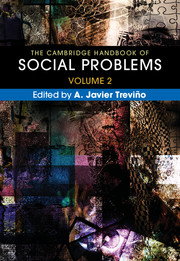Book contents
- The Cambridge Handbook of Social Problems
- The Cambridge Handbook of Social Problems
- Copyright page
- Contents
- About the Contributors
- Introduction
- Part I Problems Related to Health, Safety, and Security
- Chapter 1 Illness and Health Care
- Chapter 2 Mental Illness and Social Problems
- Chapter 3 Substance Abuse
- Chapter 4 Epidemics, Pandemics, and Outbreaks
- Chapter 5 Disaster as Social Problem and Social Construct
- Chapter 6 Surveillance
- Chapter 7 Domestic Spying: A Historical-Comparative Perspective
- Chapter 8 Computer Hacking as a Social Problem
- Chapter 9 War and Militarism
- Chapter 10 The Social Problem of Terrorism
- Chapter 11 Genocide
- Part II Problems Related to Crime and Violence
- Part III Problems of Global Impact
- Index
- References
Chapter 11 - Genocide
from Part I - Problems Related to Health, Safety, and Security
Published online by Cambridge University Press: 16 March 2018
- The Cambridge Handbook of Social Problems
- The Cambridge Handbook of Social Problems
- Copyright page
- Contents
- About the Contributors
- Introduction
- Part I Problems Related to Health, Safety, and Security
- Chapter 1 Illness and Health Care
- Chapter 2 Mental Illness and Social Problems
- Chapter 3 Substance Abuse
- Chapter 4 Epidemics, Pandemics, and Outbreaks
- Chapter 5 Disaster as Social Problem and Social Construct
- Chapter 6 Surveillance
- Chapter 7 Domestic Spying: A Historical-Comparative Perspective
- Chapter 8 Computer Hacking as a Social Problem
- Chapter 9 War and Militarism
- Chapter 10 The Social Problem of Terrorism
- Chapter 11 Genocide
- Part II Problems Related to Crime and Violence
- Part III Problems of Global Impact
- Index
- References
Summary
Genocide is a political concept designed to guarantee cultural groups a right to life comparable to that guaranteed to individuals by human rights. Its meaning is essentially contested and ranges from restricted definitions which focus on deliberate physical extermination of ethnic or racial groups to broader definitions which include systematic cultural destruction and/or the annihilation of political and social groups. Genocide can be found throughout human history, and it has been practiced by groups of all cultural and ideological orientations. In the modern era, genocide has been implemented by socialist, fascist, and liberal governments and by Western and non-Western states. Contemporary theories of genocide focus on the interaction of power struggles involving processes of class, gender, culture, and social psychology. Effective prevention will require going beyond armed humanitarian intervention to address the fundamental procedures by which nation-states handle cultural difference.
- Type
- Chapter
- Information
- The Cambridge Handbook of Social Problems , pp. 173 - 196Publisher: Cambridge University PressPrint publication year: 2018



